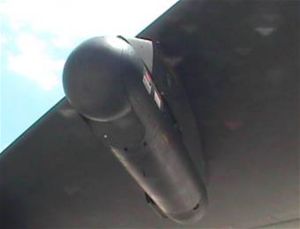LITENING: Difference between revisions
imported>Howard C. Berkowitz No edit summary |
imported>Howard C. Berkowitz mNo edit summary |
||
| (2 intermediate revisions by the same user not shown) | |||
| Line 1: | Line 1: | ||
{{subpages}} | {{subpages}} | ||
[[Northrop Grumman]] '''LITENING''' pods are a series of electro-optical target acquisition and tracking pods, which mount on a wing pylon of a variety of aircraft. Their core capabilities are a [[forward-looking infrared|forward-looking infrared/thermal imager (FLIR)]] | [[Image:B52 LITENING closeup.jpg|right|300px|thumb|LITENING electro-optical pod on B-52]] | ||
Originally developed by Israel's Rafael Industries, [[Northrop Grumman]] '''LITENING''' pods, less frequently known by their formal designation of '''AN/AAQ-28''', are a series of electro-optical target acquisition and tracking pods, which mount on a wing pylon of a variety of aircraft. Their core capabilities are a | |||
*640 x 512 pixel [[forward-looking infrared|forward-looking infrared/thermal imager (FLIR)]] | |||
*1024 x 1024 pixel [[low-light television]] (LLTV) | |||
*[[laser rangefinder]]/[[laser designator]] | |||
*[[infrared]] rangefinder and designator, dual-wavelength for jam resistance | |||
These are coupled with with a system to align the instrument views with the orientation of the aircraft. In later models, an optional feature allows air-to-ground transmission of the imagery. | |||
It has gone through several generations, from LITENING II to ER to the current AT. Evolutionary technical steps have involved increasing the range and resolution of the FLIR and LLTV, and adding countermeasures resistance to the designators. | It has gone through several generations, from LITENING II to ER to the current AT. Evolutionary technical steps have involved increasing the range and resolution of the FLIR and LLTV, and adding countermeasures resistance to the designators. | ||
Aircraft equipped with versions of the pod include the [[AV-8B]], [[A-10 Thunderbolt II]], [[B-52]], [[F-15E Strike Eagle]], [[F-16 Fighting Falcon]], [[F-18 Hornet]], and [[F-18 Super Hornet]] aircraft. User countries include Australia, the Netherlands, Portugal, Spain and the United States. | Aircraft equipped with versions of the pod include the [[AV-8B]], [[A-10 Thunderbolt II]], [[B-52]], [[F-15E Strike Eagle]], [[F-16 Fighting Falcon]], [[F-18 Hornet]], and [[F-18 Super Hornet]] aircraft. User countries include Australia, Finland, India, Italy, Israel, the Netherlands, Portugal, Spain and the United States. | ||
Wing-mounted pods, however, are not [[stealth|stealthy]], so the next generation of attack aircraft, such as the [[F-35 Joint Strike Fighter]], have similar electro-optical technology, but mounted inside the fuselage, typically with optical apertures on the nose. | Wing-mounted pods, however, are not [[stealth|stealthy]], so the next generation of attack aircraft, such as the [[F-35 Joint Strike Fighter]], have similar electro-optical technology, but mounted inside the fuselage, typically with optical apertures on the nose. | ||
Latest revision as of 20:25, 14 June 2010
Originally developed by Israel's Rafael Industries, Northrop Grumman LITENING pods, less frequently known by their formal designation of AN/AAQ-28, are a series of electro-optical target acquisition and tracking pods, which mount on a wing pylon of a variety of aircraft. Their core capabilities are a
- 640 x 512 pixel forward-looking infrared/thermal imager (FLIR)
- 1024 x 1024 pixel low-light television (LLTV)
- laser rangefinder/laser designator
- infrared rangefinder and designator, dual-wavelength for jam resistance
These are coupled with with a system to align the instrument views with the orientation of the aircraft. In later models, an optional feature allows air-to-ground transmission of the imagery.
It has gone through several generations, from LITENING II to ER to the current AT. Evolutionary technical steps have involved increasing the range and resolution of the FLIR and LLTV, and adding countermeasures resistance to the designators.
Aircraft equipped with versions of the pod include the AV-8B, A-10 Thunderbolt II, B-52, F-15E Strike Eagle, F-16 Fighting Falcon, F-18 Hornet, and F-18 Super Hornet aircraft. User countries include Australia, Finland, India, Italy, Israel, the Netherlands, Portugal, Spain and the United States.
Wing-mounted pods, however, are not stealthy, so the next generation of attack aircraft, such as the F-35 Joint Strike Fighter, have similar electro-optical technology, but mounted inside the fuselage, typically with optical apertures on the nose.
